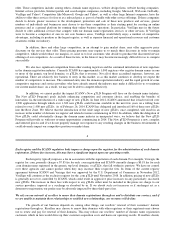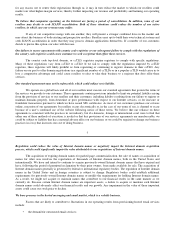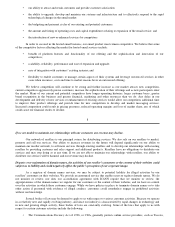Tucows 2013 Annual Report Download - page 19
Download and view the complete annual report
Please find page 19 of the 2013 Tucows annual report below. You can navigate through the pages in the report by either clicking on the pages listed below, or by using the keyword search tool below to find specific information within the annual report.
•
changes in tax laws, regulations, accounting principles or the interpretations of such laws.
16
In the event we are unable to satisfy regulatory requirements relating to internal control over financial reporting, or if
these internal controls are not effective, our business and financial results may suffer.
Section 404 of the Sarbanes-Oxley Act of 2002 requires us to evaluate the effectiveness of our internal control over
financial reporting as of the end of each year, and to include a management report assessing the effectiveness of our internal
control over financial reporting in each Annual Report on Form 10-K. Our management, including our Chief Executive
Officer and Chief Financial Officer, does not expect that our internal control over financial reporting will prevent all errors
and all fraud. A control system, no matter how well designed and operated, can provide only reasonable, not absolute,
assurance that the control system's objectives will be met. Further, the design of a control system must reflect the fact that
there are resource constraints, and the benefits of controls must be considered relative to their costs. Controls can be
circumvented by the individual acts of some persons, by collusion of two or more people, or by management override of the
controls. Over time, controls may become inadequate because changes in conditions or deterioration in the degree of
compliance with policies or procedures may occur. Implementation of new technology related to the control system may
result in misstatements due to errors that are not detected and corrected during testing. Because of the inherent limitations in
a cost-effective control system, misstatements due to error or fraud may occur and may not be detected.
As a result, we cannot assure you that significant deficiencies or material weaknesses in our internal control over
financial reporting will not be identified in the future. Any failure to maintain or implement required new or improved
controls, or any difficulties we encounter in their implementation, could result in significant deficiencies or material
weaknesses, cause us to fail to timely meet our periodic reporting obligations, or result in material misstatements in our
financial statements. Any such failure could also adversely affect the results of periodic management evaluations regarding
disclosure controls and the effectiveness of our internal control over financial reporting required under Section 404 of the
Sarbanes-Oxley Act of 2002 and the rules proclaimed after that. The existence of a material weakness could result in errors
in our financial statements that could result in a restatement of financial statements, cause us to fail to timely meet our
reporting obligations and cause investors to lose confidence in our reported financial information, leading to a decline in our
stock price, and it could make it more difficult for us to attract and retain qualified persons to serve on our Board of Directors
or as executive officers.
Impairment of goodwill and other intangible assets would result in a decrease in earnings.
Current accounting rules require that goodwill and other intangible assets with indefinite useful lives may no longer
be amortized, but instead must be tested for impairment at least annually. These rules also require that intangible assets with
definite useful lives be amortized over their respective estimated useful lives to their estimated residual values, and reviewed
for impairment whenever events or changes in circumstances indicate that the carrying amount of an asset may not be
recoverable. To the extent such evaluation indicates that the useful lives of intangible assets are different than originally
estimated, the amortization period is reduced or extended and, accordingly, the quarterly amortization expense is increased or
decreased. We have substantial goodwill and other intangible assets, and we would be required to record a significant charge
to earnings in our financial statements during the period in which any impairment of our goodwill or intangible assets is
determined. Any impairment charges or changes to the estimated amortization periods could have a material adverse effect
on our financial results.
We could suffer uninsured losses.
Although we maintain general liability insurance, claims could exceed the coverage obtained or might not be
covered by our insurance. While we typically obtain representations from our technology and content providers and
contractual partners concerning the ownership of licensed technology and informational content and obtain indemnification
to cover any breach of these representations, we still may not receive accurate representations or adequate compensation for
any breach of these representations. We may have to pay a substantial amount of money for claims that are not covered by
insurance or indemnification or for claims where the existing scope or adequacy of insurance or indemnification is disputed
or insufficient.
17
























